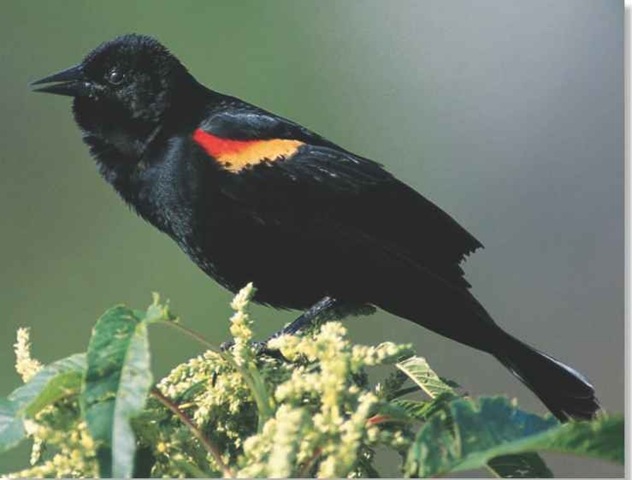ORDER
Passeriformes
FAMILY
Icteridae
GENUS & SPECIES
KEY FEATURES
Only mature males display brilliant red shoulder epaulets
One of the earliest migrants to the northern U.S. and Canada; marks its arrival with song Helps control insect populations but is also a crop pest: eats berries, fruits and grains
WHERE IN THE WORLD!
Breeds from the southern Yukon across Canada to Nova Scotia, south to Costa Rica; also in California, Cuba and the Bahamas
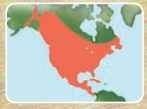
Lifecycle
The red-wing welcomes spring with its song; while its appetite for insects helps control pests, its preference for berries and grains makes it unwelcome at farms and orchards.
HABITAT
The red-winged blackbird thrives in areas near water, such as marshes, bogs and swamps, lakes and ponds or sluggish streams. It can often be seen perched in small trees and bushes. Males are the first to arrive at the breeding grounds in spring and early summer, and choose their territories based on the availability of safe nesting and roosting sites, as well as an abundance of food — marshes and hayfields are preferred.
In August, the birds move to more secluded areas; by the fall migration, males and females reappear briefly in the marshes and then move south in large flocks across the U.S. to find areas near open water
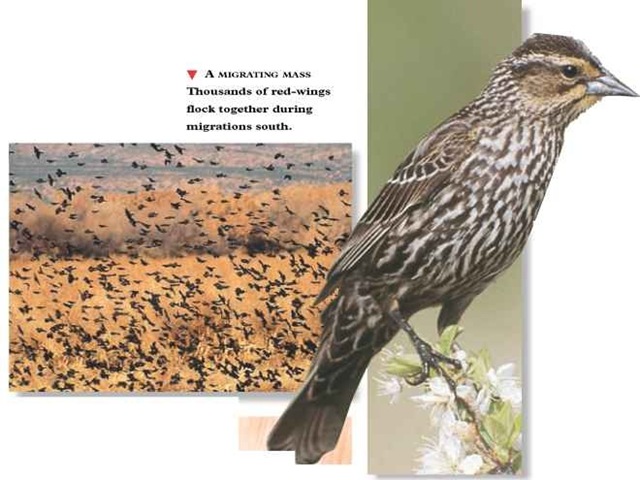
A Captive audience A female perches and listens to a male’s song.
In Arkansas, 30 roosting places accommodate an estimated 50 million red-winged blackbirds.
The red-winged blackbird’s flight speed has been recorded at up to 28 mph during migrations.
CONSERVATION
The red-wing population is extremely strong; in Ohio it increased 300% over three years. But the red-winged blackbird is a chief culprit in crop destruction in the U.S., causing up to $100 million a year in damage. Most damage occurs when the young leave the nest, consuming berries and fruits along their way.With its exploding population, the red-wing will continue its mass consumption of crops unless population control measures are put into place. One method being tried is sterilization agents given through baited feed.
BEHAVIOR
Tremendously territorial, the redwing exhibits its most aggressive behavior during the spring. With his early arrival, the male esta-blishes his position through song and display. By early March, the red-wing utters its first call, konkare, proclaiming the arri-val of spring. Three visual displays are used to declare territory depending on the situation. The male sings from prominent perches within the chosen terri-tory; this display is accompanied by the ookalee call. The bird also shows its epaulets. The second display is a song flight as the bird reenters the territory, occa-sionally with his epaulets flared. The third display is the bill tilt, which takes place without sound when birds meet at territorial borders; the male also flares his epaulets. Most activity occurs in the morning and late afternoon.There is a lot of jockeying for sites, sometimes for weeks.
BREEDING
The mating ritual of the red-winged blackbird is a complex series of interactions in which the male impresses the female with his displays and song. From their perches, males bow and crouch, arching their wings until the bright-red and yellow wing patches catch the attention of the females. A rapid series of whimpering whistles from the ‘ male indicate that pair formation has started. The female builds the nest, made of woven materials such as grass and other leaves. Females incubate the eggs for about 12 days as the male remains nearby, guarding the territory.The newborn birds are naked and blind, requiring both parents for protection and feeding. At 10 days old, the young crawl out of the nest and perch in cover, such as stands of cattails, before they are able to fly. If they fall into the water, chances of survival are slim because of the nearby water snakes, bullfrogs and snapping turtles waiting to make a meal of the young birds. When the parents leave to start a new brood, the young form flocks with other juveniles and feed and roost together The male red-wing averages three mates each breeding season.
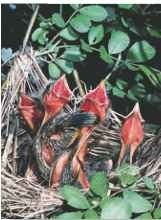
A WORK OF ART
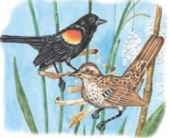
Weaving the base…
A female red-wing weaves thin strips of vegetation around lengths of bulrush as the male watches close by.
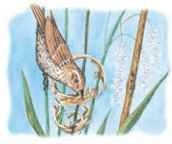
Strong foundation…
The female receives no help during the construction process but beautifully crafts the suspended nest with wet grass.
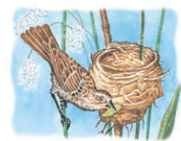
Intricate details…
She adds wet leaves and bark to form the cup, 3” in diameter, that will hold and protect the helpless hatchlings.
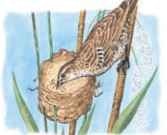
Finishing touches
After lining the nest with mud, the female adds a soft layer of fine grass that will cushion the 3—4 pale bluish-green eggs.
FOOD & FEEDING
The red-wing is an opportunistic omnivore, eating both plant and animal matter. The bird uses its bill to prospect for potential food sources, including crunchy arthropods, such as grasshoppers and crickets. Its taste for insects, particularly inchworms, moths, cutworms and wireworms, makes it beneficial to humans. However; its preference for berries and grains makes it a pest. The red-winged blackbird feeds during the day in open farm country and also snacks on breads and birdseed mixes at backyard feeders. Adult birds feed mostly insects to the young. When feeding with the flock, the red-wing walks deliberately on the ground or runs or hops to keep up with the other
birds. In late summer and fall, thousands of red-wings mix with cowbirds and starlings to feed in the open fields on weed seeds.
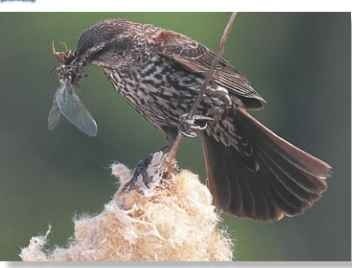
Pest control A female red-wing catches a meal for her young.
PROFILE
Red-winged Blackbird
Only the male red-winged blackbird has red wings; its strikingly handsome plumage is designed to attract the drabber female.
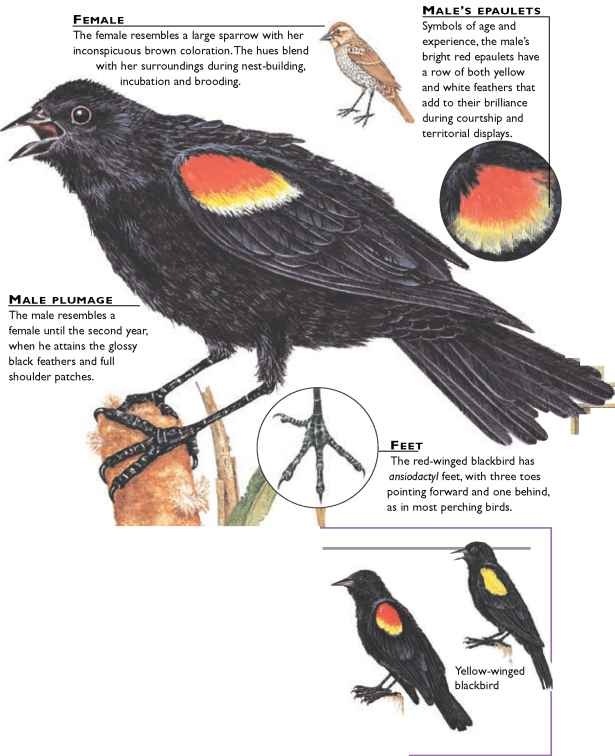
Red-winged blackbird
CREATURE COMPARISONS
The male yellow-winged blackbird (Agelaius thilius) is black, like the red-wing, but has yellow shoulders and underwing coverts. Like the red-wing, the yellow-winged blackbird marks the arrival of spring with song. It is the southern counterpart of the red-wing, found over the southerly parts of South America, from Bolivia and southern Brazil to Patagonia. The yellow-winged blackbird remains monogamous during its lifetime and is not territorial, unlike its close relative. Males often fly in flocks of 30-40, remaining apart from larger groups of females and the young outside of the breeding season.
| VITAL Weight Length |
STATISTICS Male up to 2.5 oz.; female up to 1.5 oz. 7-9.5″ |
| Wingspan | 12-14.5″ |
| Sexual Maturity | Male 2 years; female 1 year |
| Breeding .. Season | March-July |
| Number of | 3-5 |
| eggs | |
| Incubation | 11-12 days |
| period | |
| ‘ Fledging | 21 days |
| period | |
| Breeding | Up to 3 broods |
| interval | per year |
| Typical | Insects, fruits, |
| diet | berries, grain and corn |
| Lifespan | Up to 15 years |
RELATED SPECIES
• The red-wing joins .eight other species in the genus Agelaius, whose members inhabit the Western Hemisphere from Alaska to Patagonia. These birds are among 90 songbird species in 24 genera in the family Icteridae, including the brown-headed cowbird, Molothrus ater, and the bobolink, Dolichonyx oryzivorus, as well as blackbirds, grackles, orioles and meadowlarks.
